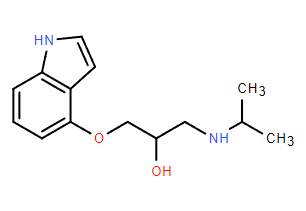Chemical Name: Pindolol
CAS No.:
13523-86-9

In the realm of cardiovascular pharmacology, Pindolol emerges as a compound of significant interest due to its dual-action mechanism and broad therapeutic applications. Pindolol(CAS No.13523-86-9) distinguishes itself from the conventional beta-adrenergic receptor antagonists through its non-selective blockade of beta receptors coupled with an intrinsic sympathomimetic activity. This unique combination not only confers antihypertensive and antianginal capabilities but also mitigates the common adverse effects typically associated with beta blockade.
At the heart of Pindolol's action is its ability to competitively inhibit the binding of catecholamines—namely epinephrine and norepinephrine—to beta-1 and beta-2 adrenergic receptors. This inhibition is pivotal in attenuating the sympathetic nervous system's influence on cardiovascular dynamics, leading to a reduction in heart rate, myocardial contractility, and ultimately, blood pressure. The therapeutic efficacy of Pindolol in managing hypertension and angina pectoris is largely attributable to these effects.
However, what sets Pindolol apart is its intrinsic sympathomimetic activity (ISA). This property allows Pindolol to exert a mild agonistic effect on the beta-adrenergic receptors, thereby sustaining a modicum of sympathetic tone to the heart. This nuanced approach ensures that while the adverse excitatory effects of catecholamines are curtailed, the heart does not plunge into the detrimental states of bradycardia or diminished cardiac output, which are common pitfalls of beta blockade therapy.
The clinical utility of Pindolol is vast, encompassing the management of hypertension and the prophylactic treatment of angina pectoris. Its pharmacokinetic profile, marked by moderate bioavailability and a half-life conducive to steady-state dosing, makes it a viable option for long-term management of cardiovascular conditions. Moreover, the comparative analysis of Pindolol against other beta blockers, such as propranolol, especially in contexts like anxiety management, reveals its versatility and adaptability to a broader spectrum of therapeutic needs.
Pindolol stands as a testament to the intricate balance between efficacy and safety in drug design, especially in the domain of cardiovascular therapeutics. Its ability to navigate the fine line between antagonizing the detrimental effects of excessive sympathetic activity while preserving the essential functions underscores its value. As research continues to unravel the complexities of cardiovascular diseases, Pindolol's role, underpinned by its dual-action mechanism, remains a beacon of hope for patients navigating the challenges of hypertension and angina pectoris.
